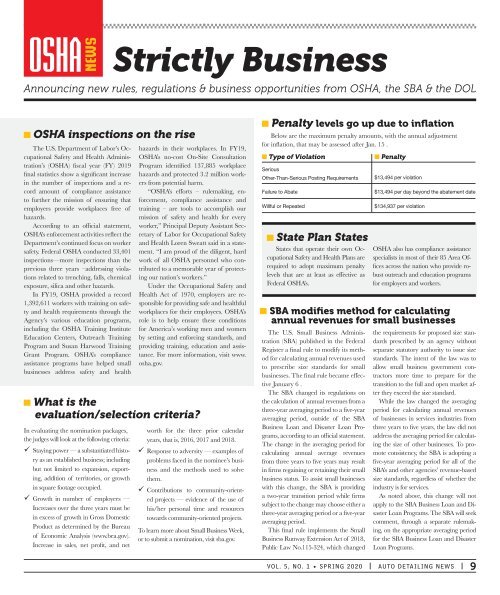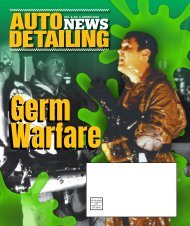Auto Detailing News
You also want an ePaper? Increase the reach of your titles
YUMPU automatically turns print PDFs into web optimized ePapers that Google loves.
OSHA<br />
NEWS<br />
Strictly Business<br />
Announcing new rules, regulations & business opportunities from OSHA, the SBA & the DOL<br />
OSHA inspections on the rise<br />
The U.S. Department of Labor’s Occupational<br />
Safety and Health Administration’s<br />
(OSHA) fiscal year (FY) 2019<br />
final statistics show a significant increase<br />
in the number of inspections and a record<br />
amount of compliance assistance<br />
to further the mission of ensuring that<br />
employers provide workplaces free of<br />
hazards.<br />
According to an official statement,<br />
OSHA’s enforcement activities reflect the<br />
Department’s continued focus on worker<br />
safety. Federal OSHA conducted 33,401<br />
inspections—more inspections than the<br />
previous three years –addressing violations<br />
related to trenching, falls, chemical<br />
exposure, silica and other hazards.<br />
In FY19, OSHA provided a record<br />
1,392,611 workers with training on safety<br />
and health requirements through the<br />
Agency’s various education programs,<br />
including the OSHA Training Institute<br />
Education Centers, Outreach Training<br />
Program and Susan Harwood Training<br />
Grant Program. OSHA’s compliance<br />
assistance programs have helped small<br />
businesses address safety and health<br />
hazards in their workplaces. In FY19,<br />
OSHA’s no-cost On-Site Consultation<br />
Program identified 137,885 workplace<br />
hazards and protected 3.2 million workers<br />
from potential harm.<br />
“OSHA’s efforts – rulemaking, enforcement,<br />
compliance assistance and<br />
training – are tools to accomplish our<br />
mission of safety and health for every<br />
worker,” Principal Deputy Assistant Secretary<br />
of Labor for Occupational Safety<br />
and Health Loren Sweatt said in a statement.<br />
“I am proud of the diligent, hard<br />
work of all OSHA personnel who contributed<br />
to a memorable year of protecting<br />
our nation’s workers.”<br />
Under the Occupational Safety and<br />
Health Act of 1970, employers are responsible<br />
for providing safe and healthful<br />
workplaces for their employees. OSHA’s<br />
role is to help ensure these conditions<br />
for America’s working men and women<br />
by setting and enforcing standards, and<br />
providing training, education and assistance.<br />
For more information, visit www.<br />
osha.gov.<br />
What is the<br />
evaluation/selection criteria?<br />
In evaluating the nomination packages,<br />
the judges will look at the following criteria:<br />
Staying power — a substantiated history<br />
as an established business; including<br />
but not limited to expansion, exporting,<br />
addition of territories, or growth<br />
in square footage occupied.<br />
Growth in number of employees —<br />
Increases over the three years must be<br />
in excess of growth in Gross Domestic<br />
Product as determined by the Bureau<br />
of Economic Analysis (www.bea.gov).<br />
Increase in sales, net profit, and net<br />
worth for the three prior calendar<br />
years, that is, 2016, 2017 and 2018.<br />
Response to adversity — examples of<br />
problems faced in the nominee’s business<br />
and the methods used to solve<br />
them.<br />
Contributions to community-oriented<br />
projects — evidence of the use of<br />
his/her personal time and resources<br />
towards community-oriented projects.<br />
To learn more about Small Business Week,<br />
or to submit a nomination, visit sba.gov.<br />
Penalty levels go up due to inflation<br />
Below are the maximum penalty amounts, with the annual adjustment<br />
for inflation, that may be assessed after Jan. 15 .<br />
■ Type of Violation<br />
Serious<br />
Other-Than-Serious Posting Requirements<br />
Failure to Abate<br />
Willful or Repeated<br />
State Plan States<br />
States that operate their own Occupational<br />
Safety and Health Plans are<br />
required to adopt maximum penalty<br />
levels that are at least as effective as<br />
Federal OSHA’s.<br />
■ Penalty<br />
$13,494 per violation<br />
$13,494 per day beyond the abatement date<br />
$134,937 per violation<br />
OSHA also has compliance assistance<br />
specialists in most of their 85 Area Offices<br />
across the nation who provide robust<br />
outreach and education programs<br />
for employers and workers.<br />
SBA modifies method for calculating<br />
annual revenues for small businesses<br />
The U.S. Small Business Administration<br />
(SBA) published in the Federal<br />
Register a final rule to modify its method<br />
for calculating annual revenues used<br />
to prescribe size standards for small<br />
businesses. The final rule became effective<br />
January 6 .<br />
The SBA changed its regulations on<br />
the calculation of annual revenues from a<br />
three-year averaging period to a five-year<br />
averaging period, outside of the SBA<br />
Business Loan and Disaster Loan Programs,<br />
according to an official statement.<br />
The change in the averaging period for<br />
calculating annual average revenues<br />
from three years to five years may result<br />
in firms regaining or retaining their small<br />
business status. To assist small businesses<br />
with this change, the SBA is providing<br />
a two-year transition period while firms<br />
subject to the change may choose either a<br />
three-year averaging period or a five-year<br />
averaging period.<br />
This final rule implements the Small<br />
Business Runway Extension Act of 2018,<br />
Public Law No.115-324, which changed<br />
the requirements for proposed size standards<br />
prescribed by an agency without<br />
separate statutory authority to issue size<br />
standards. The intent of the law was to<br />
allow small business government contractors<br />
more time to prepare for the<br />
transition to the full and open market after<br />
they exceed the size standard.<br />
While the law changed the averaging<br />
period for calculating annual revenues<br />
of businesses in services industries from<br />
three years to five years, the law did not<br />
address the averaging period for calculating<br />
the size of other businesses. To promote<br />
consistency, the SBA is adopting a<br />
five-year averaging period for all of the<br />
SBA’s and other agencies’ revenue-based<br />
size standards, regardless of whether the<br />
industry is for services.<br />
As noted above, this change will not<br />
apply to the SBA Business Loan and Disaster<br />
Loan Programs. The SBA will seek<br />
comment, through a separate rulemaking,<br />
on the appropriate averaging period<br />
for the SBA Business Loan and Disaster<br />
Loan Programs.<br />
VOL. 5, NO. 1 • SPRING 2020 | AUTO DETAILING NEWS | 9

















